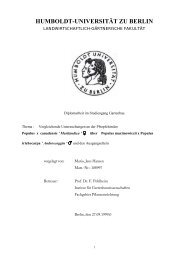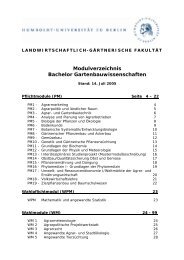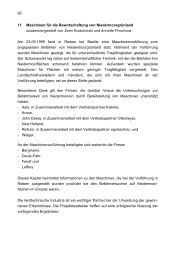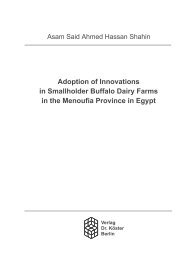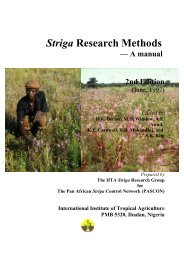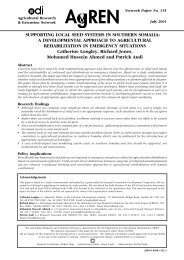Rice-Wheat Cropping Systems of the Indo-Gangetic Plain of India
Rice-Wheat Cropping Systems of the Indo-Gangetic Plain of India
Rice-Wheat Cropping Systems of the Indo-Gangetic Plain of India
You also want an ePaper? Increase the reach of your titles
YUMPU automatically turns print PDFs into web optimized ePapers that Google loves.
amalgamated into one larger zone to give<br />
17 ACZs, in all. The 17 rice-wheat (RW)<br />
growing ACZs, have been designated as<br />
(A1, A2,…F1 as depicted in Fig. 2b). The<br />
zone-names have been detailed in Table 1.<br />
The modified ACZs formulated have thus<br />
been used for detailed meso-analysis <strong>of</strong> ricewheat-growing<br />
areas (RWGA) <strong>of</strong> <strong>the</strong> IGP.<br />
Numbering <strong>of</strong> zones has been done from <strong>the</strong><br />
most productive to <strong>the</strong> least productive<br />
zone, in each region, in <strong>the</strong> descending<br />
order.<br />
Again, because sizeable scatter <strong>of</strong> rice<br />
and wheat areas is observed in certain<br />
tracts adjacent to <strong>the</strong> IGP, even though<br />
<strong>the</strong>y do not strictly form part <strong>of</strong> <strong>the</strong> IGP,<br />
<strong>the</strong> regions E1 and E2 <strong>of</strong> <strong>the</strong> Western<br />
Himalayan ACR <strong>of</strong> Himachal Pradesh, and<br />
E3, <strong>the</strong> Kumaon and Garhwal Hills <strong>of</strong> Uttar<br />
Pradesh and F1 comprising Santhal Pargana<br />
and Singhbhum regions <strong>of</strong> Bihar, have also<br />
been included in this analysis. However,<br />
due to lack <strong>of</strong> data, an important RWGA<br />
district Sri Ganganagar in Rajasthan, could<br />
not be included in this analysis.<br />
The information relating to zonecharacterization<br />
is largely based on<br />
information provided by Ghosh (1991) and<br />
Basu and Guha (1996).<br />
Distribution <strong>of</strong> <strong>Rice</strong> and<br />
<strong>Wheat</strong> in <strong>the</strong> IGP<br />
The data on rice area refer to <strong>the</strong> 5-year<br />
mean for 1991–95 (Fig. 3). However, wheat<br />
area data are averaged over four years,<br />
1991–94, as data for a number <strong>of</strong> newly<br />
formed districts could not be obtained<br />
(Fig. 4).<br />
Meso-analysis for <strong>Rice</strong><br />
Agroclimatic Region VI: Trans-<br />
<strong>Gangetic</strong> <strong>Plain</strong> Region (Punjab and<br />
Haryana)<br />
ACZ A1—Central <strong>Plain</strong> Zone: This zone<br />
comprises <strong>the</strong> central plain districts <strong>of</strong><br />
Punjab state, and out <strong>of</strong> all <strong>the</strong> RWCA <strong>of</strong><br />
<strong>the</strong> IGP, it shows <strong>the</strong> maximum<br />
concentration <strong>of</strong> rice (Fig. 3).<br />
Agroclimatologically, this zone falls in <strong>the</strong><br />
low rainfall zone <strong>of</strong> 400–800 mm. But this<br />
zone has <strong>the</strong> unique advantage <strong>of</strong> enjoying<br />
<strong>the</strong> highest irrigation intensity in <strong>the</strong><br />
country, with more than 94% <strong>of</strong> net area<br />
sown being irrigated through a network <strong>of</strong><br />
perennial canals (Bist-Doab Canal, Upper<br />
Bari-Doab Canal, Sirhind Canal and <strong>the</strong><br />
Bakhra Canal <strong>Systems</strong>) and nearly 0.8<br />
million tubewells. Groundwater reserves are<br />
being fully exploited with <strong>the</strong> result that<br />
this area is showing a sharp decline in<br />
groundwater-table, averaging 20 cm per<br />
annum (Narang and Gill 1994). But at<br />
places <strong>the</strong> rate <strong>of</strong> water-table decline is as<br />
high as 100 cm per annum or even more;<br />
with <strong>the</strong> consequence that sustainability <strong>of</strong><br />
rice cultivation is at risk. In spite <strong>of</strong> this,<br />
an increase in rice area has continued<br />
because stable high yield <strong>of</strong> rice is<br />
harvested with a liberal use <strong>of</strong> fertilizers<br />
(120–150 kg N/ha or more), overall<br />
congenial growing conditions (bright<br />
sunshine duration <strong>of</strong> 13–14 hrs or more)<br />
during most <strong>of</strong> <strong>the</strong> active growth period <strong>of</strong><br />
rice and a continuous replenishment <strong>of</strong><br />
irrigation water. Although costly, operating<br />
an additional diesel pump over and above<br />
<strong>the</strong> electric pumps, along with availability <strong>of</strong><br />
canal water, makes rice <strong>the</strong> most<br />
productive, and <strong>the</strong> only crop choice for<br />
farmers during <strong>the</strong> kharif (rainy season)<br />
season.<br />
The farmers grow rice on light sandy<br />
loam/loam textured soils found on more<br />
than half <strong>of</strong> this zone. It requires 1500 mm<br />
<strong>of</strong> irrigation water applied over 100–110 day<br />
active crop growing phase besides <strong>the</strong> 330<br />
mm average normal effective rain received<br />
during <strong>the</strong> growing season (Narang and<br />
Gulati 1992). The water application consists<br />
<strong>of</strong> scheduling 20–25 cm water at land<br />
7



